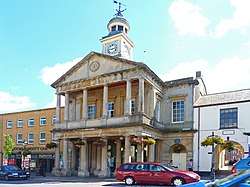History
The Guildhall was built between 1834 and 1835 to replace the town's original 16th century guildhall and market house. [1] Owing to the inconvenient position of the original hall at Fore Street, the decision to erect a replacement was finalised in 1833. [2] [3] The foundation stone of the new hall was laid on 20 December 1834. [4] Designed by the local architect Richard Carver of Taunton in the Classical style, it originally incorporated a town hall, market house and butchery, and cost over £3,000 to build. [5] The building, which also served as the local corn exchange, first opened on 21 September 1835. [6]
The guildhall clock was manufactured by A. Payne, [7] and installed to celebrate the accession of Queen Victoria to the throne in 1837; [8] it strikes the hours and chimes the quarters on two bells. [9] The building has been Grade II* listed since 1950. [2]
Much of the building's interior was remodelled around 1970, [2] with the entire building later undergoing renovation work between 1998 and 2003. [10] The weather vane on top of the building, which is 7 feet (2.1 m) high and weighs 32 stone (450 lb; 200 kg) was taken down for restoration by a local blacksmith in spring 2002. [11]
The guildhall was the meeting place of the municipal borough of Chard, formed in response to the Municipal Corporations Act 1835. [12] It ceased to be the local seat of government when, following further local government re-organisation, [13] the enlarged South Somerset Council was formed in 1974. [14] The Guildhall has housed the offices of Chard Town Council since 2009, and is also regularly used by local community groups for a variety of activities. [15]
The mechanism for the guildhall clock, weighing 200 kilograms (440 lb), was removed during the renovation of the building and returned, fully restored, in spring 2008. [8]
This page is based on this
Wikipedia article Text is available under the
CC BY-SA 4.0 license; additional terms may apply.
Images, videos and audio are available under their respective licenses.

